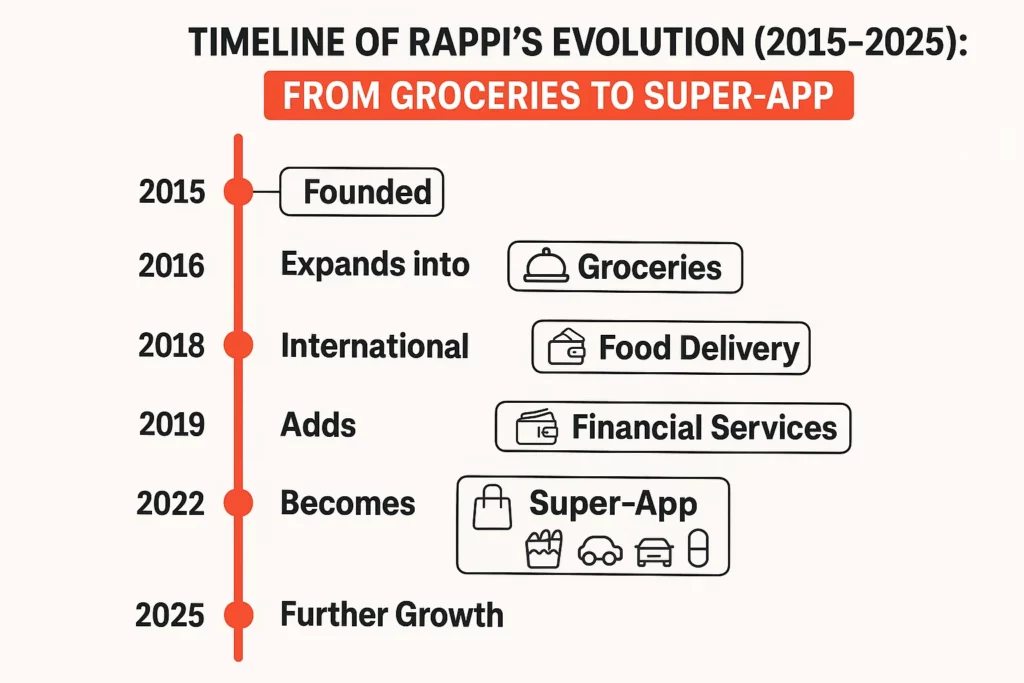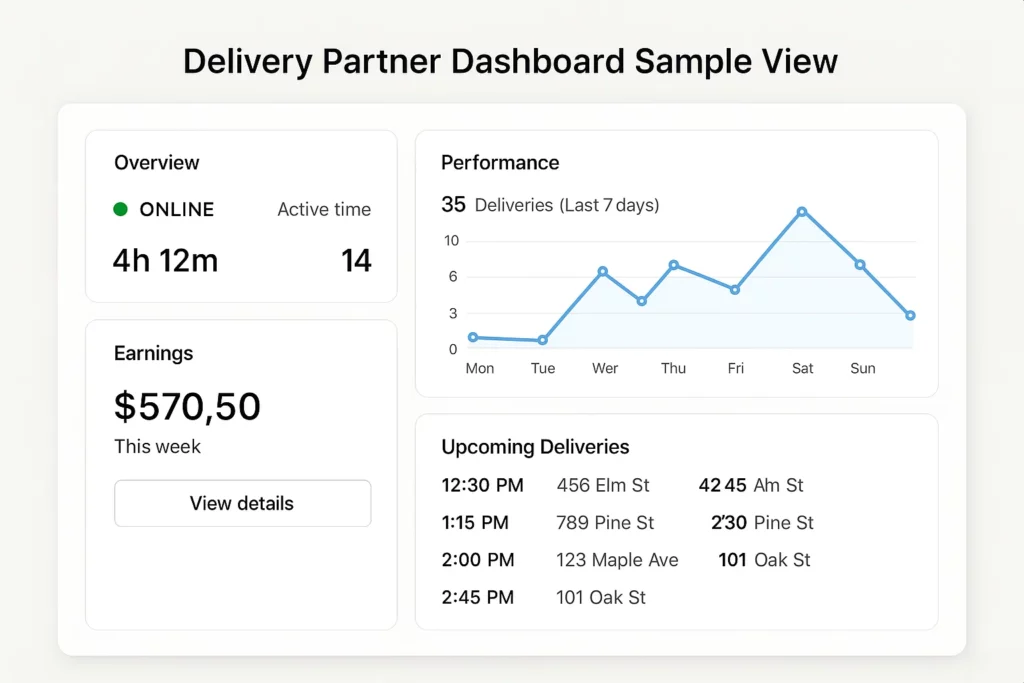So, picture this: It’s late, you’re tired, your fridge looks like a ghost town, and your stomach’s growling like it’s got a grudge. You grab your phone and—bam—Rappi to the rescue. In minutes, there’s a guy on a motorbike handing you a burger like he’s your personal superhero. That’s the magic of Rappi.
What started as a grocery delivery idea in Colombia quickly turned into a full-blown lifestyle app. Today, Rappi isn’t just delivering food—it’s delivering convenience, time, and options. Whether you’re craving sushi, need a pharmacy run, or even want to send your keys across town, Rappi’s your go-to.
And for entrepreneurs, that’s a juicy opportunity. Super-apps like Rappi are changing the game—and guess what? Miracuves helps you launch your own version, fully loaded and ready to scale. Let’s break down what makes Rappi tick, and how you can clone the concept smartly.
What is Rappi?
A Quick Snapshot
Rappi is a Colombian-born on-demand delivery app that’s grown into one of Latin America’s biggest tech success stories. Launched in 2015, it started with groceries but now lets users:
- Order restaurant food
- Shop groceries
- Book courier services
- Get cash deliveries
- Access travel and events
- Even hire personal assistants (yes, really)
Think of it as the Latin American cousin of DoorDash, Uber Eats, Instacart, and TaskRabbit—rolled into one turbocharged mobile app.

How Does the Rappi App Work?
1. User App – Convenience at Your Fingertips
The user opens the Rappi app on their smartphone, chooses a service (food, groceries, pharmacy, etc.), adds items to the cart, pays, and tracks the delivery in real time.
Key Features:
- Geolocation & address auto-fill
- Multi-store cart
- Live tracking
- Ratings & reviews
- Push notifications
Explore Rappi’s powerful features — from multi-category ordering (groceries, restaurants, pharmacies) to real-time delivery tracking.
2. Delivery Partner App – The Backbone of Rappi
Delivery partners (a.k.a. Rappitenderos) accept orders, follow optimized routes, and communicate with users for smooth drop-offs. They get real-time order updates, earnings reports, and incentives.
UX Notes:
- Interactive map & route suggestions
- Multilingual options
- Emergency button
- Earnings dashboard

3. Vendor App – Power to the Shops
Restaurants, supermarkets, and stores manage orders, update inventory, and track performance via a separate merchant dashboard.
Common Capabilities:
- Menu & pricing management
- Order alerts
- Performance analytics
- Promotions & offers
Rappi’s Business & Revenue Model
Rappi is the poster child for “monetize everything” in the delivery game. Here’s how they rake in cash:
Commission-Based Model
Vendors pay a commission (15–30%) on every order. Higher visibility = higher fees.
Delivery Fee
Customers pay a base delivery fee depending on distance, urgency, and type of service.
Subscription: RappiPrime
Unlimited free deliveries, special offers, and early access to sales—for a monthly or annual fee.
Ads & Sponsored Listings
Restaurants and stores pay to appear higher in search or be featured during app scrolls.
Financial Services & RappiPay
With RappiPay (digital wallet + credit card), Rappi’s stepping into fintech territory—offering payments, loans, and even crypto cashback.
Why Entrepreneurs are Cloning Rappi
Let’s face it—Rappi’s not just a service; it’s a lifestyle app. And that opens doors for:
- Hyperlocal startups in untapped Tier II cities
- Niche delivery apps (only pharmacy, vegan restaurants, etc.)
- All-in-one super-apps targeting countries where Rappi isn’t present
The gold rush isn’t over—it’s just shifting territories.
Unpack Rappi’s scalable business model — designed for hyperlocal delivery — and its diversified revenue streams across service categories and digital services.
Key Tech Behind Rappi’s Success
Rappi didn’t win just by being fast—it won by being smart. Under the hood:
- AI-powered suggestions: Based on user behavior, time, and day
- Dynamic pricing algorithms: Adjust delivery fees in real-time
- Custom-built CMS for multi-vendor management
- Microservices architecture: Ensures scalability during surge hours
- Real-time communication stacks: Built using WebSockets + Firebase
Challenges Faced (and Lessons to Learn)
Even giants stumble. Rappi has dealt with:
- Heavy delivery fleet churn – Addressed by bonuses and gamification
- Legal hurdles in fintech – Solved via localized licensing
- Operational chaos during peaks – Handled with predictive load balancing
Lesson? If you’re building a Rappi-like app, you need smart automation, regulatory awareness, and flexible logistics. That’s where experienced partners (hint: Miracuves) come in handy.
What’s Next for Rappi (And Its Clones)?
Rappi’s expanding into AI-powered customer support, same-hour logistics, and even drone deliveries. For entrepreneurs cloning the model, here’s what to watch:
- Voice-based ordering
- Virtual shopping assistants
- Augmented reality menus
- Cross-border micro-commerce
The bar’s rising. But if you’re bold enough to build now, you can surf the next wave instead of being drowned by it.
Explore the best Rappi clone scripts of 2025, learn how to build your own multi-service app like Rappi, and apply proven marketing strategies for rapid user growth.
Conclusion
Rappi didn’t just build an app—it built habits. Daily ones. That’s the holy grail for digital businesses.
If you’re itching to create something impactful, profitable, and scalable, a Rappi-style super-app is a seriously smart bet. The concept’s proven. The demand’s growing. All that’s left? A killer execution.
At Miracuves, we help innovators launch high-performance app clones that are fast, scalable, and monetization-ready. Ready to turn your idea into reality? Let’s build together.
FAQs
What services does the Rappi app offer?
Rappi delivers food, groceries, medicine, cash, and more. It also offers courier services and even financial services like RappiPay.
Is Rappi available worldwide?
Nope—it mainly serves Latin American countries like Colombia, Mexico, Brazil, and Argentina. But the model works anywhere with smartphone users and hungry people!
How does Rappi make money?
Via delivery fees, vendor commissions, premium subscriptions (RappiPrime), advertising, and financial services.
Can I launch my own app like Rappi
Absolutely! With the right tech partner—like Miracuves—you can get a Rappi clone tailored to your region, market, and audience.
What’s the tech stack for a Rappi clone app?
Typical stacks include Flutter or React Native (frontend), Node.js or Laravel (backend), Firebase (notifications), and AWS or GCP (cloud hosting).
How long does it take to build a Rappi clone?
Depending on features, it can take 4–8 weeks for a robust MVP. Miracuves can fast-track this with ready-to-go components.








